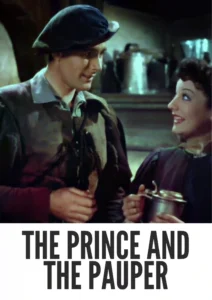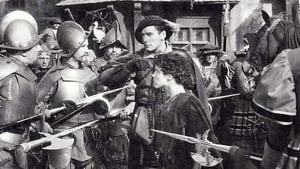Video Sources 0 Views

Synopsis
Swashbuckling Adventure Awaits: The Prince and the Pauper (1937) in Dazzling Color

Embark on a timeless adventure with The Prince and the Pauper, a captivating story based on Mark Twain’s novel, now beautifully colorized for a modern audience. Starring Errol Flynn, this film brings to life a world of mistaken identities, royal intrigue, and daring sword fights. Perfect for fans of classic literature and swashbuckling tales, this HD download offers a visually stunning experience that captures the heart and spirit of the original story. This movie is also known as Mark Twain’s The Prince and the Pauper.
The Prince and the Pauper Storyline: A Tale of Two Look-Alikes
The Prince and the Pauper tells the story of two boys born on the same day in 16th-century England: Edward Tudor, the Prince of Wales, and Tom Canty, a poor beggar. Through a chance encounter, the two boys discover they look exactly alike and decide to temporarily exchange clothes as a lark.The switch leads to unforeseen consequences as each boy is thrust into the other’s world. Tom is mistaken for the prince and must navigate the treacherous waters of the royal court, while Edward is cast out into the streets and experiences the harsh realities of poverty. As they struggle to adapt to their new lives, both boys learn valuable lessons about themselves and the world around them. The story culminates in a dramatic showdown as Edward reclaims his rightful place as heir to the throne. Ultimately, The Prince and the Pauper is a timeless tale of identity, justice, and the power of compassion.
Movie Cast
The film features a stellar cast of actors who bring this classic story to life:
- Errol Flynn as Captain Alan Errol
- Claude Rains as Earl of Hertford
- Billy Mauch as Prince Edward Tudor / Tom Canty
- Bobby Mauch as Prince Edward Tudor / Tom Canty
- Alan Hale Sr. as John Canty
Movie Genre
The Prince and the Pauper falls into the genre of swashbuckling adventure, with elements of historical drama and family entertainment. Its themes of identity, justice, and compassion make it a captivating and engaging film for audiences of all ages.
Historical Context: A Golden Age of Adventure Films
Released in 1937, The Prince and the Pauper represents a highlight of Hollywood’s Golden Age of adventure films. During this period, studios produced lavish historical epics and swashbuckling tales that captivated audiences with their thrilling action, romantic storylines, and larger-than-life characters. The Prince and the Pauper reflects the values and sensibilities of its time, offering a romanticized vision of the past while exploring timeless themes of social justice and human connection. The film was produced during a time when Hollywood was at the height of its creative and commercial power, and it exemplifies the studio system’s ability to produce high-quality entertainment for a mass audience.
Colorization Details
This colorized version of The Prince and the Pauper has been meticulously restored using modern digital techniques, enhancing the visual appeal while preserving the film’s original charm and atmosphere. The colorization process involved carefully analyzing the grayscale tones of the original black and white footage and assigning appropriate colors to each scene. While the specific software used remains proprietary, the techniques employed included advanced algorithms for color palette selection and image enhancement. This painstaking process brings new life to the characters and settings, making the story even more engaging for modern audiences. While some may debate the merits of colorizing classic films, it introduces these films to a broader audience, ensuring their legacy for future generations.
Technical Details
- Director: William Keighley
- Screenplay: Laird Doyle
- Based on: the novel by Mark Twain
- Cinematography: Sol Polito
- Edited by: Ralph Dawson
- Production Company: Warner Bros.
- Distributed by: Warner Bros.
- Runtime: 118 minutes
Technical Specifications
- Download Format: MP4
- Resolution: HD (1080p)
- Compatibility: Compatible with most devices, including smartphones, tablets, computers, and smart TVs.
Reviews and Critical Reception
The Prince and the Pauper (1937) is widely regarded as a faithful and entertaining adaptation of Mark Twain’s classic novel. Critics praised the film for its lavish production values, thrilling action sequences, and strong performances from the cast. The film was a commercial success upon its release and has since become a beloved classic, enjoyed by generations of audiences. As a timeless tale of identity, justice, and compassion, The Prince and the Pauper continues to resonate with viewers of all ages.
FAQs
- Q: What is The Prince and the Pauper about?
- A: The Prince and the Pauper is a story about two boys who switch places and experience each other’s lives.
- Q: Is this version of The Prince and the Pauper colorized?
- A: Yes, this version has been professionally colorized to enhance the viewing experience.
- Q: What makes The Prince and the Pauper a classic film?
- A: The Prince and the Pauper is a classic film due to its timeless story, memorable characters, and thrilling adventure sequences.
- Q: What is the download format?
- A: The download format is MP4, which is compatible with most devices.
- Q: What resolution is the download?
- A: The resolution is HD (1080p), providing a high-quality viewing experience.
Download Now in HD!
Watch The Prince and the Pauper Today!











